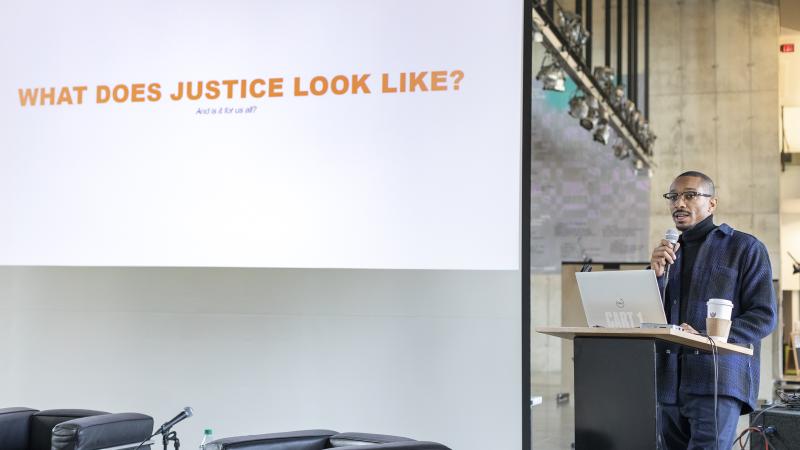“Building on Layers of History”: Race, Space, & The Unifying Power of Design Symposium
Planners, architects, landscape architects, and artists gathered in Knowlton Hall to participate in conversations about race in an effort to create more equitable urban environments in the Midwest. The two-day symposium, Race, Space, & The Unifying Power of Design, was organized by the 2022–23 Trott Distinguished Visiting Professor Matt Williams.
“I want someone to walk away from the symposium feeling more confident to have tough conversations about race,” said Williams, who is currently the Senior Advisor on Neighborhood Economic Development for the City of Detroit. “I think more unites us than divides us, but often the things that divide us get the attention and media coverage. One thing I want to highlight is the collaborative process of design—the actual process of community engagement and multi-disciplinary teams with diverse individuals.”

Hosted by the Landscape Architecture Section in the Knowlton School, the event opened on day one with the themes of policy and pedagogy. Joyce Huang, who leads the Planning Department for the City Planning Commission of Cleveland, and Antoine Bryant, Director of Detroit’s Planning and Development Department, presented recent design initiatives that have successfully activated urban spaces through community engagement.
Huang discussed her work on AsiaTown and the Hough neighborhood of Cleveland as examples of urban renewal predicated on community history. “It’s really about building on relationships,” said Huang. “Building from the ground up. Building on the respect and the words of our elders. Building on layers of history.”
Focusing on affordable housing efforts achieved through the Detroit Strategic Neighborhood Fund, Bryant addressed the broader issue of how to operationalize trust at the institutional level. “We are fomenting a premise of inclusive design by ensuring that our residents play a key role in what design looks like,” said Bryant on his department’s efforts to break down walls and silos to make design more integrated within Detroit.

Day two of the symposium opened with Williams posing the question, What does justice look like? to the speaker line-up of Midwest design practitioners. Bryan C. Lee, Jr. (BSArch ’06), founder and principal designer of the New Orleans-based Colloqate, responded with an overview of the design justice movement and how his practice is shaped by the understanding that multiple systems require an answer that is not just architectural or spatial in nature, but political in nature. “When we talk about design justice, we are talking about a way of practice that seeks to envision spaces of racial, social, and cultural justice,” said Lee. “It’s a way for us to challenge the privilege and power structures that use architecture and design as a tool of oppression.”
Imani Day, founding principal of RVSN Studios, indicated she moved to Detroit in 2015 at the height of the city’s bankruptcy to focus on designing and building socially inclusive spaces across multiple scales of impact. She presented on the collaborative project, The Grand River—Livernois Strategic Development Plan, whose aim was to strengthen and celebrate community identity in a neighborhood that suffered from neglect and land vacancies.

Following a panel discussion with Lee and Day moderated by Landscape Architecture Assistant Professor of Practice Tameka Baba, the afternoon continued with presenters Ujijji Davis Williams and Dayton Schroeter. Williams, a founding partner of JIMA Studio in Detroit, posed the question: “How can architecture respond to the pressing present—and not just the aspirational future or the nostalgic past?” She pointed to how in our current times of crisis, art, architecture, and design have become more urgent as tools to confront systematic challenges that people continue to endure.
Dayton Schroeter, Vice President and National Design Director of SmithGroup, is an architect, artist, exhibition designer, and social activist who seeks to push black narratives into the mainstream to educate people about the past. He provided an overview of several projects focused on black historic sites of trauma and resilience. Schroeter featured the interpretive installation, Society’s Cage, a 15' x 15' raised pavilion consisting of nearly 500 suspended weathered steel rods that form a perfect cube. The experience of the installation is to challenge visitors to reckon with America’s long history of racial injustice.

Landscape Architecture Section Head Kristi Cheramie emphasized the importance of partnership practices rather than provider practice, a subject discussed across all the presentations, in her closing remarks for the symposium. “The work that everyone talked about is technical, it is inherently durational, and it is distributed,’ Cherami concluded. “This is an amazing way to think about the future of practice, but it is also a provocative set of ideas to have inside the academy, inside Knowlton Hall, about how students are participating in pedagogy and how we are writing curriculum.”
In addition to the symposium, Matt Williams and Ujijji Davis Williams curated a corresponding exhibition in Knowlton Hall’s Banvard Gallery titled What Could We Do Here? Urban Design Strategies for Vacant Land in Detroit. The exhibition featured drone photography of vacant lots in Detroit, a Detroit history timeline from 1805 through 2022, and Trott Seminar students’ design proposals. The exhibition highlights both the history of vacant land in Detroit as well as opportunities for its just, humane, and community-focused revitalization.


